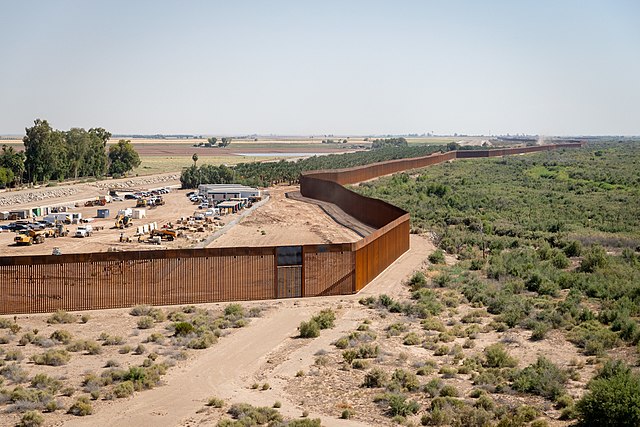Artists: Bahaleen (PS), Border Emergency Collective (PL), Anna Engelhardt and Mark Cinkevich (UK/BY), fantastic little splash (UA), Martyna Marciniak (PL), Oleksiy Radynski (UA), Firas Shekhadeh (PS), Tytus Szabelski-Różniak (PL), Filip Wesołowski (PL)
Curators: Bartosz Frąckowiak, Ewa Kozik, Paweł Wodziński / Fundacja Biennale Warszawa (_BW_Lab)
Communication: Marta Bogacz, Xénia Oszvald
Production coordinator: Rita Kálmán
Production: OFF-Biennále Budapest & Fundacja Biennale Warszawa (_BW_Lab)
Address: Margit körút 5/A (District 2), Budapest
Openning: 8 May, 17:00
Opening hours: 9 May – 15 June 2025
• Wednesday: 16:00–19:00
• Thursday–Friday: 16:00–20:00
• Saturday–Sunday: 10:00–16:00
* * *
The exhibition Granice bezpieczeństwa | Biztonsági határok | Security / Borders critically explores the concept of security through the lens of technology, featuring works situated at the intersection of contemporary art, politics, and society. While security infrastructures are often presented as protective, the exhibition highlights how they can also operate as instruments of control—reinforcing authoritarian tendencies even within democratic systems.
The project, curated by the Biennale Warszawa Foundation (_BW_Lab) team, investigates how narratives of safety and protection are used to amplify societal fear, justify surveillance, and restrict civil liberties. Through diverse artistic practices, the exhibition reflects on pressing questions around borders, technological development, public order, and the future of security.
The exhibition investigates how security discourse and policies become tools to coerce social consent for expanding regimes of control and surveillance, implemented through increasingly ubiquitous infrastructures and technologies. The project focuses on areas such as: border and territorial protection, public order and domestic politics, armed conflicts and wars, critical infrastructure and digital threats, the connections between security and technological development.
Most of the works on display are recent – either commissioned specifically for the exhibition, or supplemented with current data – forensic and postforensic works that analyse the development of digital surveillance and manipulation technologies, and uncover the role of the powers these tools serve. Focusing on geographic areas such as Eastern Europe, including Ukraine, Russia, Poland and Belarus, or the Middle East, primarily Palestine, Jordan and Syria, the works show the progressive radicalisation of methods used by increasingly authoritarian powers. In this new planetary order, increasing technological capabilities are leading to escalating armed conflicts, wars or acts of genocide.
The exhibition Granice bezpieczeństwa | Biztonsági határok | Security / Borders brings to light the fact that security is not a universal value, given to all equally, but primarily a tool and ideology of domination and segregation, and prompts both the question of the limits of our acceptance of this state of affairs and key questions about the future: How will security-related practices evolve? What role will technologies play in them? Is it possible to harness the potential of technology to build security systems that genuinely protect civil rights and freedoms rather than restrict them?
The exhibition is a collaborative project between OFF-Biennále Budapest and the Biennale Warszawa Foundation (_BW_Lab) and it is presented within the framework of the 2025 edition of OFF-Biennále Budapest, following a long-standing collaboration between the both organisations.
* * *
Bahaleen Counter-Logistics of Piercing Borders (2025), single-channel video
In the video Counter-Logistics of Piercing Borders, the Palestinian collective Bahaleen examines border control infrastructure in Jordan. The artists combine field recordings, archival materials, and digital traces (such as Google Maps records, chats, shared links) with their own journeys along Jordan’s borders with Palestine, Syria, and Iraq. This multilayered assemblage reveals the intertwined mechanisms of militarization, surveillance, and capital that sustain territorial divisions – while simultaneously showing that even “rigid” borders have their cracks and zones of permeability.
Bahaleen consciously departs from classic documentary narrative, introducing intentional gaps and discontinuities. This fragmentary approach challenges the role of artist-researcher as neutral narrator and proposes a strategy of controlled opacity in contrast to surveillance regimes demanding full visibility. The installation employs diverse materials – from protest livestreams and leaked security camera footage to amateur videos – layering them with voiceover commentary and textual insertions. In this way, the work questions the authority of maps and journalistic conventions, pointing to counter-surveillance as a form of resistance. Rather than offering a closed account, Bahaleen reveals the research and mapping process itself. This ambiguous form counteracts omnipresent observation, fueling the political imagination of return, liberation, and border abolition.
Commissioned by _BW_Lab

Bahaleen, ‘Counter-Logistics of Piercing Borders’ (2025)
Bahaleen is a group of friends, sometimes colleagues, and often collaborators who are Palestinian artists, architects, surveyors, calligraphers, and researchers based in Jordan. Together, they are a research group dedicated to exploring the emancipatory potentials of arts practice through a constellation of acts, projects, and productions. In recent years, Bahaleen has been engaged in several multi-year independent research projects that circle around notions of temporality, crossing borders, and impermanent-permanent infrastructures.
* * *
Border Emergency Collective Zone of Hidden Violence (2022), two-channel video projection, 14’ 35”
The humanitarian crisis at the Polish-Belarusian border that began in 2021 left dozens of invisible victims. The border zone under state of emergency became an information black hole – migrants’ dramas unfold there without external witnesses. Between 2021-2022 the Border Emergency Collective set out to meticulously document and reconstruct stories from this ‘death zone’. Zone of Hidden Violence is a two-channel video projection that reconstructs two of these narratives – accounts of people who experienced violence, illegal pushbacks, and human rights violations by officers on both Polish and Belarusian sides.
The creators employed digital forensics – an innovative fusion of art and criminology, where individual visual and audio evidence comprises a compelling indictment of state violence. They gathered witness testimonies (including spatial reconstructions of events from memory), geolocation data, audiovisual materials, and 3D models to create coherent reconstructions. The result is a film serving as an investigative document, revealing hidden acts of violence in the crisis-affected border zone. The resulting material demonstrates how, in the name of ‘security,’ both sides of the conflict committed brutal practices against migrants. Border Emergency Collective’s work gives voice to victims and challenges official narratives that previously masked the truth about these events.
Commissioned by Biennale Warszawa | Consultation and content-related support: Forensic Architecture | Partners: Helsinki Foundation for Human Rights, Nomada Association, Forensic Architecture and Grupa Granica

Border Emergency Collective, ‘Zone of Hidden Violence’ (2022)
Border Emergency Collective is a research team specialising in combining activist practice with theory, OSINT and experience in the field of architecture and film. The group was formed in response to the ongoing humanitarian crisis on the Polish-Belarussian border and the increasing scale of violence toward migrant people perpetrated by the officials of both countries.
* * *
Anna Engelhardt & Mark Cinkevich Terror Element (2025), installation: single-channel video 25’, television, camera, explosive detection kit, laboratory table
This video installation interrogates the use of forensic science as an instrument of state power. The work follows a fictional investigator who attempts to reconstruct an actual case: the 1999 apartment bombings in Russia. As she searches through archival footage from state TV, the boundary between evidence, interpretation, and fabrication starts to dissolve. Soon, doubt seeps in: would her own forensic methods stand up to scrutiny?
The installation stages part of the onscreen crime lab, featuring a CRT monitor displaying the film and an HD camcorder capturing a live feed of the set. This recursive mise-en-scène invites viewers to examine the act of witnessing and how it affects the construction of truth.
Commissioned by Framer Framed and supported by Film London Artists’ Moving Image Network (FLAMIN), Netherlands Film Fund and Creative Industries Fund NL.
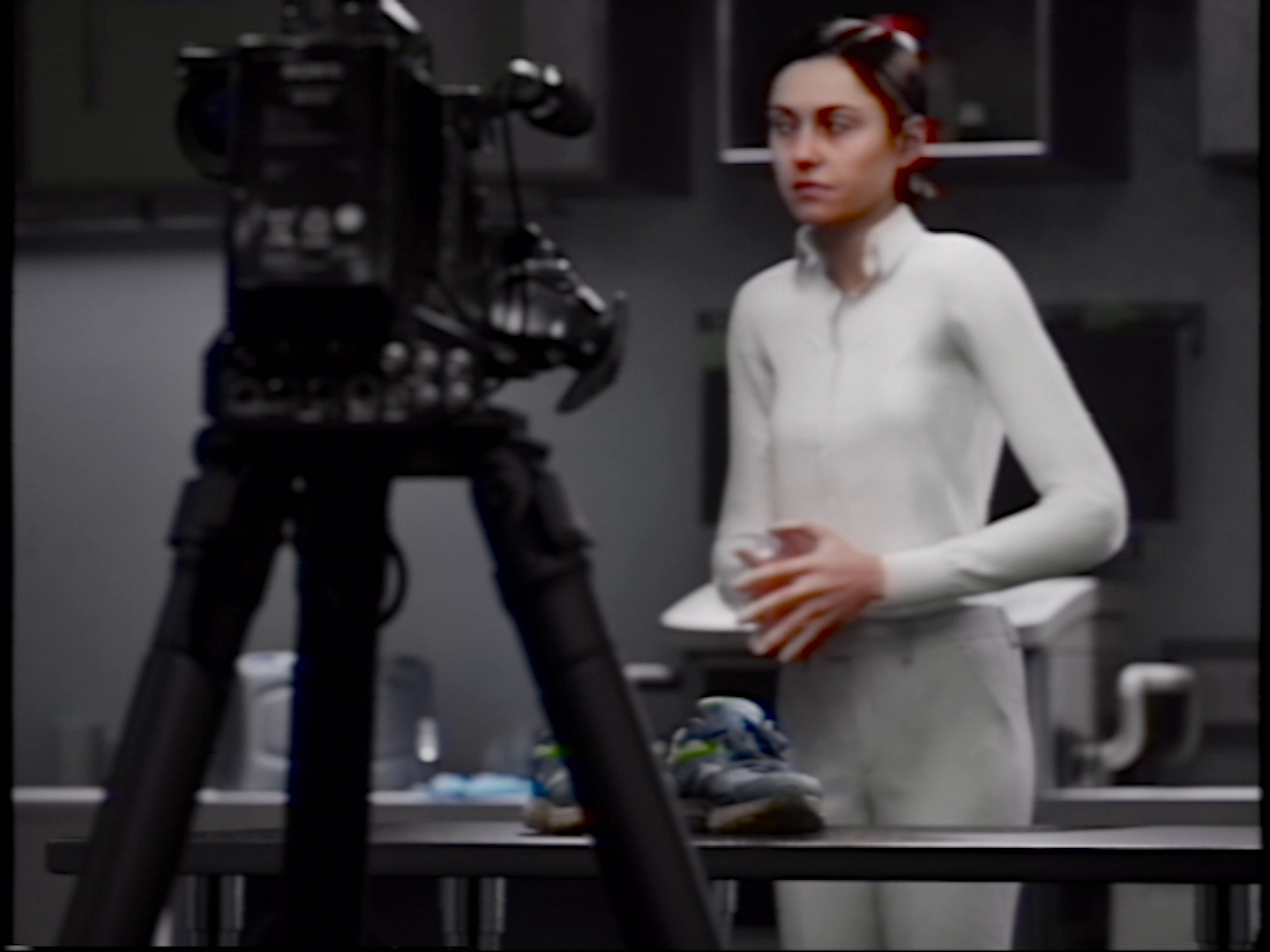
Anna Engelhardt & Mark Cinkevich ‘Terror Element’ (2025)
Anna Engelhardt is the alias of a video artist and writer. Her investigative practice follows the traces of material violence, focusing on what could be seen as the ‘ghost’ of information. The toxic information environments she deals with stem from structures of extraction, occupation and dispossession. Engelhardt has shown her work at Transmediale, Berlin; Ars Electronica, Linz; Kyiv Biennial; the Henie Onstad Triennial for Photography and New Media, Høvikodden; and the National Gallery of Art, Vilnius. She lives in London.
Mark Cinkevich is an interdisciplinary researcher and artist. In his practice, he is interested in critical, speculative, and experimental aspects of art that operate at the intersection of fact and fiction. His work focuses on the post-Soviet infrastructural and social landscape, through which he explores in particular the concepts of nuclear colonialism, infrastructural colonialism, extractivism, and monstrosity. Cinkevich has shown his work at transmediale, Berlin; steirischer herbst, Graz; BFI London Film Festival, London; National Gallery of Art, Vilnius; Ars Electronica, Linz; and Aksioma Institute for Contemporary Art, Ljubljana, among others. He lives in Warsaw.
* * *
fantastic little splash infocry (2024 – ongoing), the chorus machine prototype
infocry was launched in 2024 to explore how online activity shapes public opinion about Ukrainian refugees in both Moldova and Germany. In 2025, BW_Lab commissioned an extension of the project to track potential threats to democracy posed by bots ahead of Poland’s May presidential election. To gather the data, fantastic little splash used Osavul – an AI-powered tool that analyzes vast amounts of text data by grouping similar comments. This technique reveals patterns among seemingly independent statements, exposing coordinated narratives across different users and publications.
The audio featured here includes examples of content produced by inauthentic actors – accounts engaging in what is known as Coordinated Inauthentic Behavior (CIB). These actors, often called social bots, are not always automated. Many are paid individuals who copy or slightly modify content to simulate personal opinion. The project draws inspiration from the Greek chorus – a foundational element of ancient Greek tragedy that helped shape modern democracy and principles of political equality. Today, while we often perceive online voices as representing ‘the people’, it is crucial to recognise that some of these emotional expressions may originate from inauthentic actors, raising questions about democratic integrity.
The project was implemented during the Truth to Justice Residency by Vitsche (Germany), and was updated especially for the Security / Borders exhibition as a part of the 5th OFF-Biennále in Budapest.

fantastic little splash, ‘Infocry’ (2024 – ongoing)
fantastic little splash is a collective comprised of journalist/artist Lera Malchenko and artist/director Oleksandr Hants. fantastic little splash combines art practice and media studies to research collective imagination and emotions appropriation in technosocial systems. Group works with videos, texts and interactive game-based tools. Established in 2016 in Ukraine, their projects have been exhibited at events including transmediale, post.MoMA, Plokta TV, Ars Electronica, Liste Art Fair Basel, Construction festival VI x CYNETART, KISFF, and Docudays, among others. fantastic little splash – participants of the transmediale x Pro Helvetia Residency 2022, and the Cité internationale des arts residency 2023.
* * *
Martyna Marciniak Anatomy of Non-Fact. The Lexicon (2025), interactive installation
Anatomy of Non-Fact.The Lexicon explores how security aesthetics – rooted in military, media, and corporate cultures – shape the way we experience the world. These visuals often justify surveillance by invoking vague or invisible threats, quietly embedding themselves into our daily lives, online platforms, and design language.
As synthetic images flood digital spaces and blur the line between real and fake, we are left searching for new ways to interpret visual information and recognise manipulation. This video essay traces how Western ideas of visual ‘truth’ have been shaped by surveillance technologies, and how those same tools now create fertile ground for mass disinformation. Using case studies of hoaxes, visual misinformation, and staged provocations, the work unpacks how visual systems present authority and how they can be exploited. Instead of asking whether an image is real, the project asks what kind of realities these images create.
The installation presents the video on smartphone screens embedded within sculptural structures that echo tools for tracking, organising, and simulating attention. As visitors interact with these forms, the video changes, exposing visual elements that are otherwise hidden or overlooked. By linking gestures with the act of looking, the viewer becomes aware of how vision is guided: we are both watchers as well as being watched – the installation invites us to reflect not just on what we see, but on how we are taught to look.
This version of the Anatomy of Non-Fact was developed especially for the Security / Borders exhibition as a part of the 5th OFF-Biennále in Budapest.

Martyna Marciniak, ‘Anatomy of Non-Fact. The Lexicon’ (2025)
Martyna Marciniak is a Polish, Berlin-based artist, researcher and 3D designer. Her work is an exploration of visual storytelling, and involves animation, film, writing and model-making. Her art practice relies on speculative fictions and allegory to expose technological and visual biases, while bridging the domains of aesthetics, law, politics and media theory. She was an artist in residence at Bauhaus Dessau Foundation in 2018 and at Akademie Schloss Solitude in 2024. Her work has been shown at the Ars Electronica Festival, Biennale Warszawa, Kinema ICON in Bucharest, Haus Gropius in Dessau and deTour Festival in Hong Kong, among others.
* * *
Oleksiy Radynski Chornobyl 22 (2023), documentary film, 21’19”
directed by Oleksiy Radynski | written by Oleksiy Radynski | produced by Lyuba Knorozok | cinematography by Max Savchenko, Anonymous | sound design by Andriy Borysenko | film editing by Taras Spivak | distribution Chicken Kyiv Films
In spring 2022, during the first days of the Ukraine invasion, Russian forces occupied the Chornobyl Nuclear Power Plant site. Oleksiy Radynski’s documentary Chornobyl 22 reconstructs these events through the eyes of Ukrainian plant workers who remained on site under enemy occupation. The director juxtaposes clandestine footage recorded by anonymous witness with staff interviews conducted months after the incident, reconstructing the atmosphere of those uncertain days. The workers – cut off from the world and surrounded by soldiers – recount fears of another nuclear catastrophe, attempting to use this threat to discourage occupiers from risky actions. After several weeks, Russian units withdrew, but their presence awakened Chornobyl’s past demons.
Radynski doesn’t stop at simple documentation of a military incident. Chornobyl 22 presents the power plant as a scene of peculiar psychological warfare, where boundaries between past and present blur. Abandoned reactors and the contaminated zone become elements of a propaganda game based on fear. The film juxtaposes Soviet control legacy with the brutal reality of invasion, showing how silence, disinformation, and the specter of past catastrophe shaped the occupation experience. By giving voice to engineers and technicians who survived this period, the director challenges heroic war narratives. Instead of battle chronicles, we receive reflection on truth’s fragility under extreme conditions and ordinary people’s quiet acts of resistance. Chornobyl 22 tells not only of war, but of memory, power, and survival in history’s shadow.
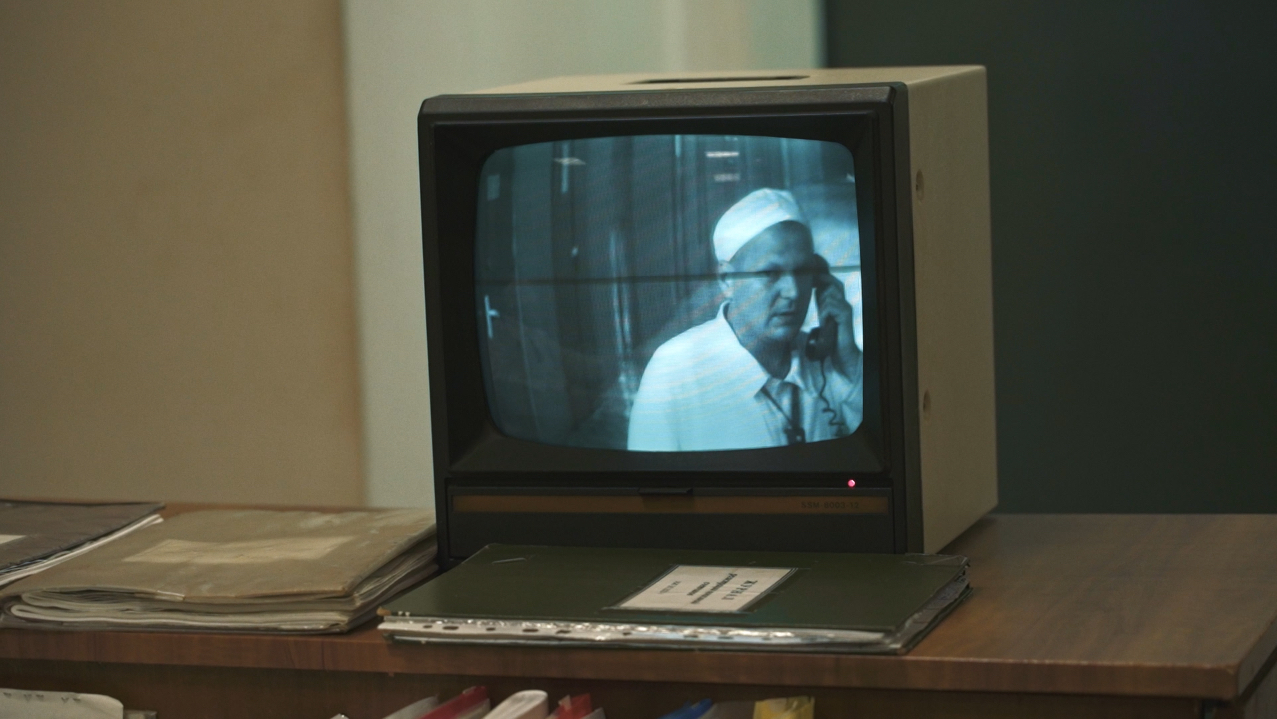
Oleksiy Radynski ‘Chornobyl 22’ (2023)
Oleksiy Radynski is a filmmaker and writer based in Kyiv. His films experiment with documentary forms and practices of political cinema. They have been screened at film festivals and exhibitions worldwide including Berlinale, International Film Festival Rotterdam, Oberhausen International Short Film Festival, the Institute of Contemporary Arts (London), e-flux (New York), Taipei Biennial, Docudays (Kyiv), Sheffield Doc Fest, Krakow IFF, DOK Leipzig etc. His films received multiple awards, including the Grand Prix at the Oberhausen International Short Film Festival for Chornobyl 22.
* * *
Firas Shehadeh Like An Event In A Dream Dreamt By Another – Rehearsal (2023), single-channel video (colour, sound), 14’20”
In the video Like An Event In A Dream Dreamt By Another – Rehearsal, Firas Shehadeh examines the intersection of virtual entertainment and challenging Palestinian reality. On one hand, the artist shows how video games – led by the cult sandbox Grand Theft Auto V [1] – can serve to process experiences of life under occupation. Digital Los Santos (the fictional GTA city modelled on Los Angeles) becomes for young Palestinians a kind of dress rehearsal space: a virtual sandbox where they can simulate daily life while archiving the realities of living under colonial violence.
On the other hand, Shehadeh combines Twitch stream fragments – recordings where Palestinian gamers modify the game – with his own interventions in GTA’s map. He treats fan mods (unofficial game modifications) as a contemporary archive: digital records of places important to Palestinian history and present, transferred to the virtual world. Consequently, Los Santos becomes saturated with “promised land” elements – virtual counterparts of lost places. Rehearsal explores the humour and aesthetics of a generation raised online, but primarily asks whether the virtual world can become a vessel for collective memory and resistance testing ground. Combining meme culture, video games, and real memories, Shehadeh reveals hidden desires and traumas of a community for whom cyberspace became the only available arena of freedom.
[1] Grand Theft Auto (GTA) is a popular video game series where players can explore large, urban environments, engage in missions, interact with the world and role-play.
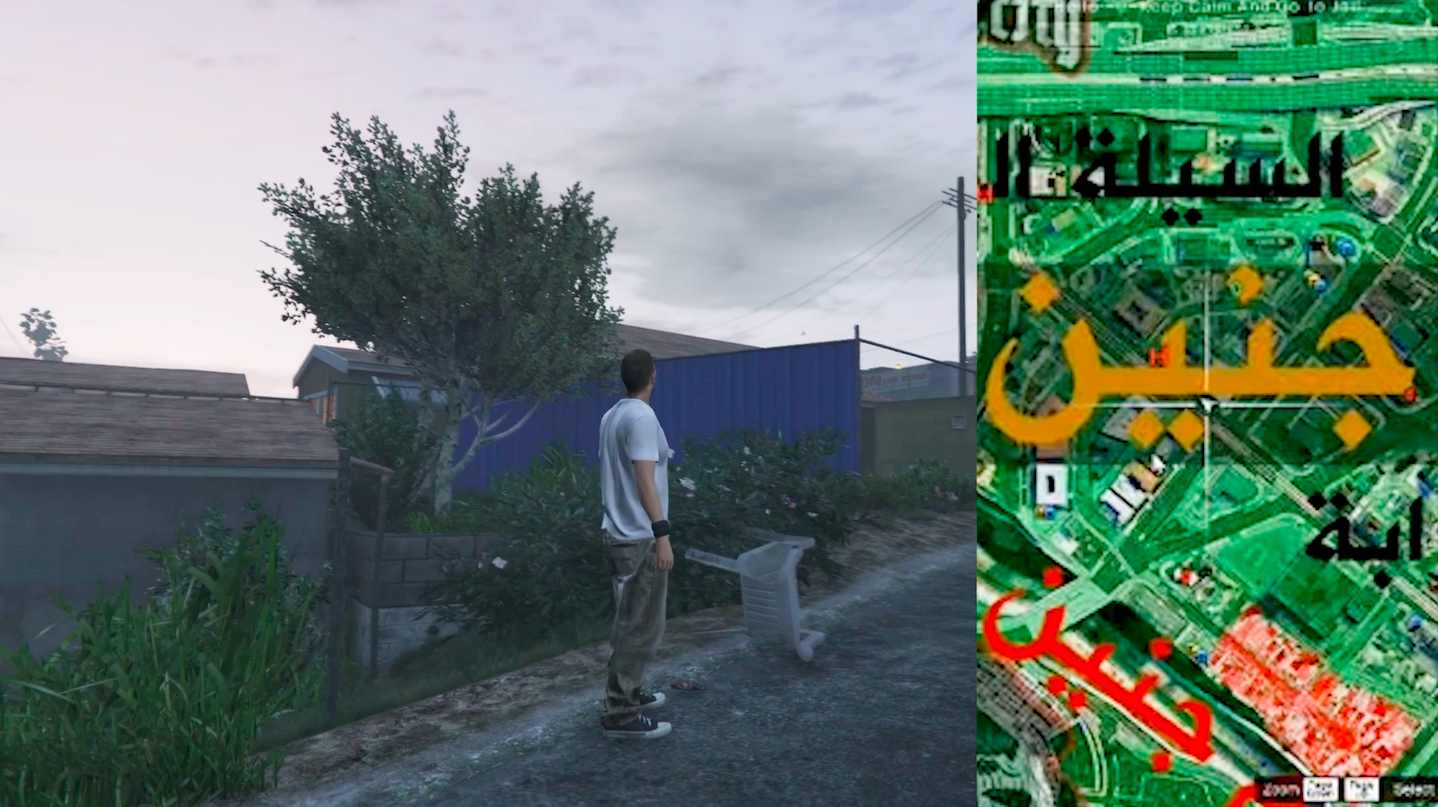
Firas Shehadeh, ‘Like An Event In A Dream Dreamt By Another – Rehearsal’ (2023)
* * *
Firas Shehadeh The Way of the Future (2025), single-channel UHD video (colour), 2-channel sound, 8’02”
The video The Way of the Future transports viewers into a post-apocalyptic world reminiscent of the video game The Last of Us. Amid virtual ruins, a lone Palestinian figure moves through desolate landscapes accompanied by real-world sounds – the Islamic call to prayer and the sound of Israeli surveillance drones. The digital decay mirrors the lived destruction experienced by Palestinians, collapsing the distance between virtual dystopia and political reality. Firas Shehadeh’s work allegorises a struggle not just for land, but for identity, memory, and presence. By blurring the lines between the real and the virtual, the artist reframes the Palestinian cause as one that transcends borders and enters global consciousness through pop culture.
At the same time, the film highlights a disturbing truth: Palestine today functions as a testing ground for advanced surveillance technologies and AI-driven warfare. Biometric monitoring systems, autonomous drones, and algorithmic targeting are deployed in real-time, transforming lived experience into data for future global conflict zones. What begins as control under occupation becomes a prototype for broader systems of domination. By combining speculative aesthetics with urgent geopolitical critique, The Way of the Future becomes more than a digital fiction – it is a powerful metaphor for life under technological occupation and the global future it foreshadows.
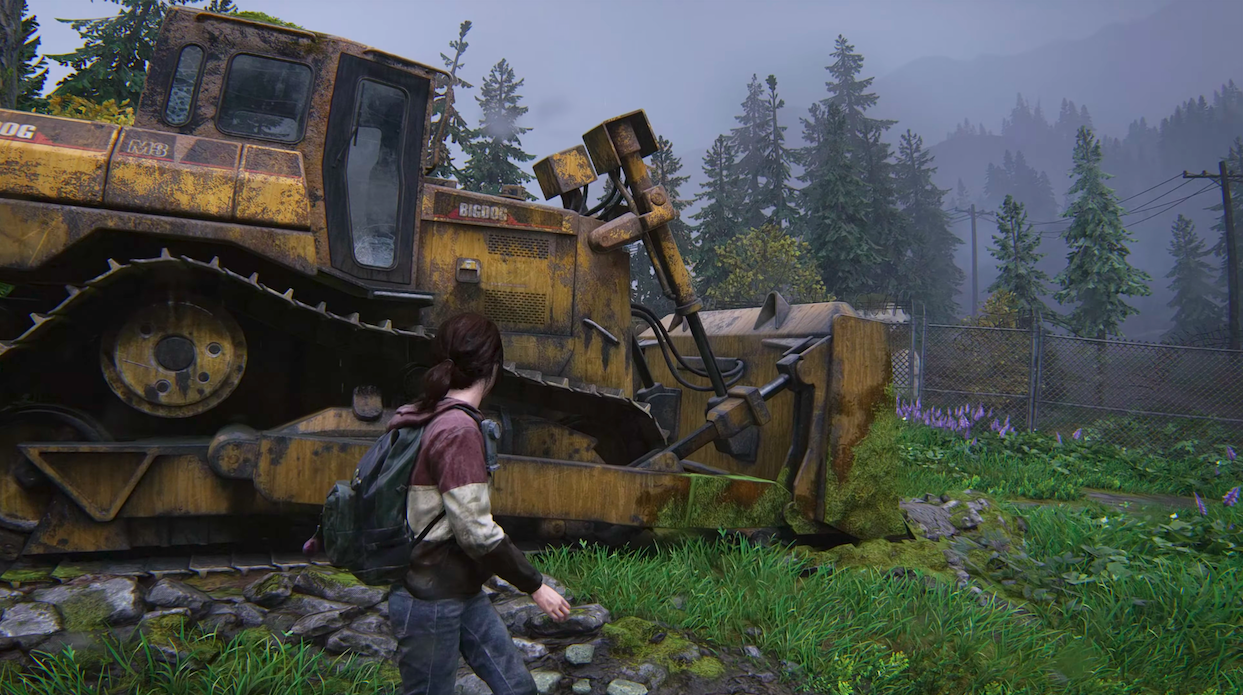
Firas Shehadeh, ‘The Way of the Future’ (2025)
Firas Shehadeh is a Palestinian artist. His work engages with worldbuilding, meaning, aesthetics, and identity after/on the Internet. He is interested in post-colonial effects, technology, and history. He holds a Master of Fine Arts from the Academy of Fine Arts Vienna.
* * *
Tytus Szabelski-Różniak Divide and Connect (2024), digital photographs, print on cotton paper, wooden box binding, 80×100 cm
The photographic series Divide and Connect presents “green bridges” spanning highways – wildlife crossings designed to restore migratory path continuity interrupted by road networks. These structures, built from concrete and steel, covered with soil and vegetation, are designed according to strict ecological guidelines and monitored continuously. Though they mimic natural landscape, they cannot hide their artificial nature. These are hybrid spaces – simultaneously nature fragment and infrastructure element, remaining under constant human control.
Szabelski-Różniak uses these eco-friendly structures as metaphor for broader flow control processes. Photographs from the Divide and Connect cycle operate on two levels: on one hand documenting transportation network elements (animal crossings over international routes in Poland), on the other prompting reflection on artificial movement corridors and imposed hierarchy. In the contemporary world, we decide who, when, and where we can move. We build highways with designated crossings, airports with separate gates, and at borders erect walls and barriers.
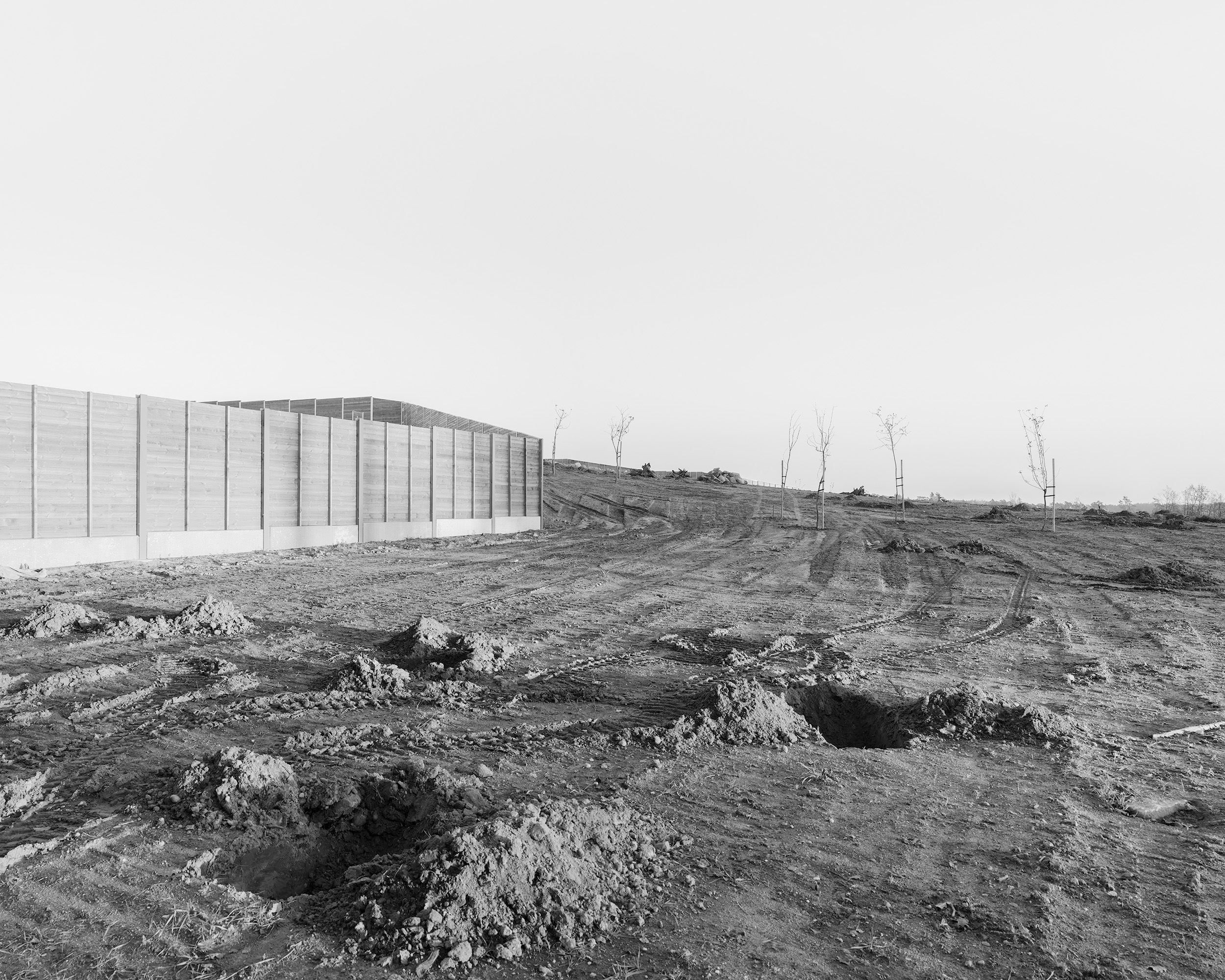
Tytus Szabelski-Różniak, ‘Divide and Connect’ (2024)
Tytus Szabelski-Różniak Unmaking (2024), 3D animation, 9’30”
composer: Hubert Karmiński | lector: Marta Markiewicz
The 3D animation Unmaking is an artistic catalog of border and transit architecture. Tytus Szabelski-Różniak compiled digital models of various structures – from bridges, border crossings, walls, and barriers separating European states, to resource transmission infrastructure like the ‘Friendship’ pipeline connecting Russia with the West. All these objects share one feature: they were designed to direct movement – enable flow of selected people or resources while simultaneously blocking or rationing it elsewhere.
The film’s narrative layer explains mechanisms of division, exclusion, and selection built into each shown structure. Szabelski-Różniak deliberately reverses perspective: instead of focusing on obvious functions of connection or transport facilitation, he directs attention to their hidden roles – dividing, controlling, and supervising access. In animated shots, border bridges, fences, and pipelines appear as contemporary tools of “divide and conquer” politics. Unmaking isn’t classical documentation but visual metaphor: using abstract form and fragmentary narrative, it highlights infrastructure’s ambiguous nature, which simultaneously integrates and segments spaces. The work references the ancient maxim divide et impera, questioning how much our freedom of movement depends on surrounding systems – and to what extent these systems define our autonomy’s limits. In Podlasie, where the artist’s lived for five years, refugees’ tragedy at the Polish-Belarusian border exposes these paradoxes: while wild animals receive safe passage through primeval forest, people fleeing war are repelled from the same border and exposed to death.

Tytus Szabelski-Różniak, ‘Unmaking’ (2024)
Tytus Szabelski-Różniak As Above, so Below (2025), pigment print on archival paper, 80×120 cm
The photograph As Above, so Below reveals an inconspicuous fragment of Starlink’s global satellite internet infrastructure. In the idyllic landscape of a central Polish village, between an apple orchard and chicken coop, rises a ground station – a Starlink system gateway – connecting Earth-orbiting satellites with terrestrial fiber optic networks.
The Starlink system, comprising several thousand satellites, aims to provide internet connectivity in hard-to-reach world regions. However, even the most futuristic technology relies on physical infrastructure located right beside us. Szabelski-Różniak reminds us of this by pointing his lens at the banal, rural scenery concealing an element crucial for network operation. Since 2022, Starlink stations have also become part of the Ukrainian war landscape – enabling Ukrainian army communication while becoming subject to political pressure from the system’s owner. As Above, so Below brings to light the material and mundane side of apparently ‘cosmic’ network. The photograph – referencing Benjamin Bratton’s concept of ‘planetary infrastructure’ – draws attention to the banality and concealment of contemporary communication’s key nodes. It turns out that elements deciding global processes and conflicts’ course can hide in inconspicuous locations – like an internet antenna hidden behind a barn in rural Poland.
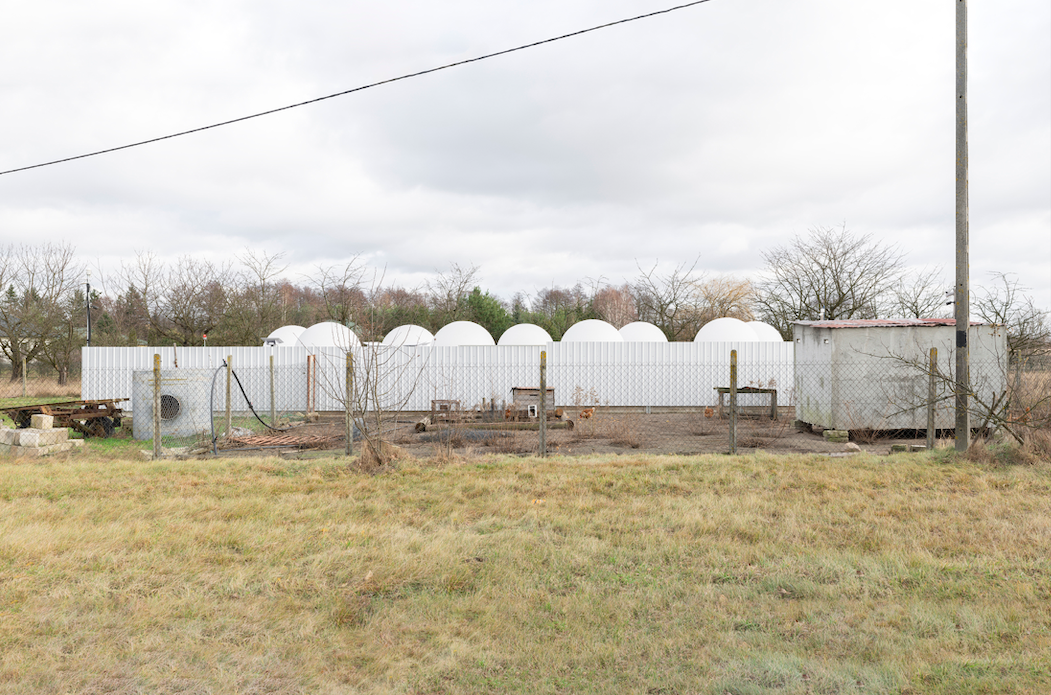
Tytus Szabelski-Różniak, ‘As Above, so Below’ (2025)
Tytus Szabelski-Różniak, born in 1991, photographer and visual artist. Graduated journalism and social communication at Nicolaus Copernicus University in Toruń, Poland, and photography at the University of Arts in Poznań, where he completed his doctoral studies. His works are part of Arsenal Municipal Gallery in Poznań art collection and Raffles Europejski Hotel in Warsaw art collection. Finalist of Polish and international contests for best art master’s diploma work (e.g StartPoint Prize 2016 in Prague, Czechia). Laureate of Konrad Pustoła memory scholarship for socially engaged photographer (2017), awarded with Visegrad Fund Sound and Visual Arts Residency (Trafó Galery, Budapest, 2021) and Biennale Warszawa residency (2020). Participant of Parallel – European Photo Based Platform, program dedicated to young photographers and curators (2019–2020) and Visual Narratives Laboratory at Łodź Filmschool, where he currently works and teaches. Former editor of “Magenta,” online magazine dedicated to contemporary photography, “Postmedium” art academic journal and Central-Eastern European art magazine “BLOK.”
* * *
Filip Wesołowski Anatomy of a Border (2025), single-channel video, ca.12’
Anatomy of a Border is a film essay examining the European border control system through its infrastructure lens. Filip Wesołowski juxtaposes cartographic data, 3D models, satellite imagery, statistics, and archival materials to show that human rights violations at borders aren’t isolated incidents but part of a broader, planned mechanism.
The artist traces various European states’ borders, capturing similarities and differences along with technology and tactics transfer between them. Over decades, a unified European Union ‘border regime’ emerged – a coherent set of regulations, policies, and technical tools collectively shaping contemporary migration control strategy. Wesołowski focuses on the Polish-Belarusian border, situating it within this continental context. Anatomy of a Border reveals how European states, exchanging knowledge and equipment, build a common fortress – from physical barriers to surveillance systems and databases. The film gives these abstract processes a visual dimension: maps and models compose a geopolitical puzzle where migrants’ local tragedies prove to be effects of global border logic. Ultimately, Wesołowski prompts viewers to look beyond individual crises and perceive the power architecture behind the concept of ‘security’ in Europe.
Commissioned by _BW_Lab
Filip Wesołowski is a graduate of the Faculty Artes Liberales at the University of Warsaw, is an artist and member of the interdisciplinary and international art and research group INTERPRT. As a member of INTERPRT, he co-created the exhibition Race and Forest presented in 2019 at the Museum of Modern Art in Warsaw and in 2020 at the Biennale Warszawa. INTERPRT’s work was also presented at the Dhaka Art Summit in 2020 (Collectives Platform), Bergen Kunsthall in 2021 (NO-CCZ), Istanbul Biennale in 2022 (Mining the Abyss) and Helsinki Biennial in 2023 (Colonial Present: Counter-mapping the truth and reconciliation commissions in Sápmi). Co-founder of Border Emergency Collective in 2022, which presented the work Zone of Hidden Violence as part of the second edition of the Biennale Warszawa Seeing Stones and Spaces Beyond the Valley in June and July 2022.
* * *
This project is co-financed by the Minister of Culture and National Heritage of the Republic of Poland from the Culture Promotion Fund.


